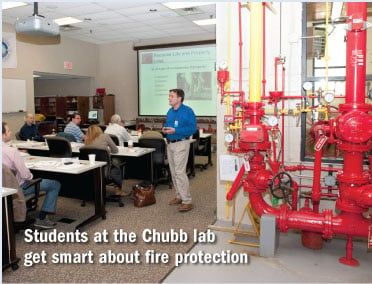Setting fires in the workplace is frowned upon by most employers, but at Chubb Insurance it's an activity that's not only actively encouraged—it's actually an essential part of the company's profit picture.
 For Chubb, a major global source of property insurance, it's crucial that its underwriters—and insureds—understand best practices in fire protection. Indeed, a key part of its strategy in avoiding catastrophic claims is to make sure both policyholders and those responsible for evaluating a building's risk profile have some hands-on experience with sprinkler systems and other use-it-or-lose-it fire-protection technology.
For Chubb, a major global source of property insurance, it's crucial that its underwriters—and insureds—understand best practices in fire protection. Indeed, a key part of its strategy in avoiding catastrophic claims is to make sure both policyholders and those responsible for evaluating a building's risk profile have some hands-on experience with sprinkler systems and other use-it-or-lose-it fire-protection technology.
Chubb built its first fire lab in the 1980s. Today, it has a best-in-class training center located on its corporate-headquarters campus in suburban New Jersey—a facility used to teach between 700 and 1,000 students a year. Those attending include Chubb staff, independent producers, insureds and fire officials from around the country and across the globe.
Recommended For You
Want to continue reading?
Become a Free PropertyCasualty360 Digital Reader
Your access to unlimited PropertyCasualty360 content isn’t changing.
Once you are an ALM digital member, you’ll receive:
- Breaking insurance news and analysis, on-site and via our newsletters and custom alerts
- Weekly Insurance Speak podcast featuring exclusive interviews with industry leaders
- Educational webcasts, white papers, and ebooks from industry thought leaders
- Critical converage of the employee benefits and financial advisory markets on our other ALM sites, BenefitsPRO and ThinkAdvisor
Already have an account? Sign In Now
© 2025 ALM Global, LLC, All Rights Reserved. Request academic re-use from www.copyright.com. All other uses, submit a request to [email protected]. For more information visit Asset & Logo Licensing.








